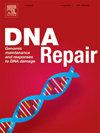Checkpoint activation and recovery: regulation of the 9–1–1 axis by the PP2A phosphatase
IF 2.7
3区 生物学
Q2 GENETICS & HEREDITY
引用次数: 0
Abstract
Genome integrity is continuously monitored by elaborate cellular networks, collectively referred to as the DNA damage response (DDR), which detect DNA lesions and transmit the information to downstream targets, thereby coordinating a broad range of biological processes. A crucial signal in this response is the generation of single-stranded DNA that, once coated by replication protein A (RPA), serves as a platform for recruiting the apical checkpoint kinase Mec1/ATR. Full activation of Mec1/ATR also requires the 9–1–1 complex, which provides a docking site for additional checkpoint mediators, such as Dpb11/TOPBP1 and Rad9/53BP1. These mediators are important for transducing the checkpoint signal from Mec1/ATR to the effector kinase Rad53/CHK2. The checkpoint signal transduction cascade is tightly regulated by phosphorylation events, which can be counteracted by phosphatases to ensure timely checkpoint inactivation once DNA repair is complete. In this review, we examine the mechanistic aspects of Mec1/ATR activation, with a particular focus on the 9–1–1 checkpoint axis in Saccharomyces cerevisiae. We discuss how phosphorylation and dephosphorylation dynamically regulate the checkpoint pathway, allowing cells to efficiently respond to genotoxic stress while ensuring a timely return to normal cell-cycle progression.
检查点激活和恢复:PP2A磷酸酶对9-1-1轴的调控
基因组完整性由复杂的细胞网络持续监测,统称为DNA损伤反应(DDR),它检测DNA损伤并将信息传递给下游目标,从而协调广泛的生物过程。这一反应中的一个关键信号是单链DNA的产生,一旦被复制蛋白A (RPA)包裹,单链DNA就会成为募集顶端检查点激酶Mec1/ATR的平台。Mec1/ATR的完全激活还需要9-1-1复合体,该复合体为其他检查点介质(如Dpb11/TOPBP1和Rad9/53BP1)提供对接位点。这些介质对于将检查点信号从Mec1/ATR转导到效应激酶Rad53/CHK2非常重要。检查点信号转导级联受到磷酸化事件的严格调控,磷酸化事件可以被磷酸酶抵消,以确保一旦DNA修复完成,检查点及时失活。在这篇综述中,我们研究了Mec1/ATR激活的机制方面,特别关注酿酒酵母的9-1-1检查点轴。我们讨论了磷酸化和去磷酸化如何动态调节检查点途径,使细胞有效地应对基因毒性应激,同时确保及时恢复正常的细胞周期进程。
本文章由计算机程序翻译,如有差异,请以英文原文为准。
求助全文
约1分钟内获得全文
求助全文
来源期刊

DNA Repair
生物-毒理学
CiteScore
7.60
自引率
5.30%
发文量
91
审稿时长
59 days
期刊介绍:
DNA Repair provides a forum for the comprehensive coverage of DNA repair and cellular responses to DNA damage. The journal publishes original observations on genetic, cellular, biochemical, structural and molecular aspects of DNA repair, mutagenesis, cell cycle regulation, apoptosis and other biological responses in cells exposed to genomic insult, as well as their relationship to human disease.
DNA Repair publishes full-length research articles, brief reports on research, and reviews. The journal welcomes articles describing databases, methods and new technologies supporting research on DNA repair and responses to DNA damage. Letters to the Editor, hot topics and classics in DNA repair, historical reflections, book reviews and meeting reports also will be considered for publication.
 求助内容:
求助内容: 应助结果提醒方式:
应助结果提醒方式:


